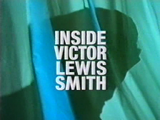 They say that restaurant critics make lousy chefs…but do television critics make lousy television? Victor Lewis-Smith is an established television critic (for the London Evening Standard) as well as writing for several other publications, and in the past Lewis-Smith had presented TV programmes such Inside Victor Lewis-Smith plus features within other shows such as BBC2’s TV Hell. His newspaper columns don’t just cover television but also nostalgia, so it’s only logical that he should also have a strong interest in television nostalgia.
They say that restaurant critics make lousy chefs…but do television critics make lousy television? Victor Lewis-Smith is an established television critic (for the London Evening Standard) as well as writing for several other publications, and in the past Lewis-Smith had presented TV programmes such Inside Victor Lewis-Smith plus features within other shows such as BBC2’s TV Hell. His newspaper columns don’t just cover television but also nostalgia, so it’s only logical that he should also have a strong interest in television nostalgia.
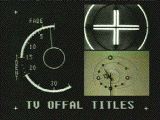
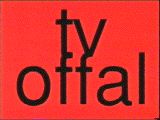
TV Offal started life as a one-off pilot programme shown on 31 October 1997. It’s incredibly difficult to summarise, but the Channel 4 press release made a valiant attempt at a precis, so to speak: ‘Having scoured the skips and bins of TV broadcasting and plundered the graveyards of student television stations, Victor has, in his own unique and bizarre fashion, constructed an archive programme that treats its material (celebrity and otherwise) with a savage combination of satire and scatology. But, in his own words: “It isn’t another It’ll be Alright on the Night, because you can tell from what you see that it’ll be anything but alright on the night.”‘ (According to television expert Andy Emmerson, that strange-looking clock in the opening titles was used by early-1960s French television.)
 From this you might have deduced that TV Offal pokes fun not only at programmes but also at programming formats and ‘celebrities’, as well as anything else that could related to television and broadcasting culture such as test cards and ident (station identification) sequences. Despite the parodying tone, it becomes rapidly self-evident that Victor himself actually revels in these ephemera of TV culture, though it’s equally obvious that he really means it when he mocks celebrities such as Noel Edmonds or Vanessa Feltz. The audio used in the link sequences is almost uniquely (for television) styled in the form of radio jingles, notably jingles specially commissioned from the world-famous American jingle producers JAM.
From this you might have deduced that TV Offal pokes fun not only at programmes but also at programming formats and ‘celebrities’, as well as anything else that could related to television and broadcasting culture such as test cards and ident (station identification) sequences. Despite the parodying tone, it becomes rapidly self-evident that Victor himself actually revels in these ephemera of TV culture, though it’s equally obvious that he really means it when he mocks celebrities such as Noel Edmonds or Vanessa Feltz. The audio used in the link sequences is almost uniquely (for television) styled in the form of radio jingles, notably jingles specially commissioned from the world-famous American jingle producers JAM.
Animal Hospice
 It seemed that viewers and critics other than Victor himself liked the pilot show, so Channel 4 went ahead with commissioning a series of six half-hour programmes which ran from May 22nd 1998, shown on Friday evenings at 11 pm. Late night Channel 4 is not exactly viewing suitable for children (as programmes such as Eurotrash or The Word have graphically illustrated), so TV Offal was able to use this scheduling to its advantage in order to show the sort of things that would have made ‘clean-up tv’ campaigner Mary Whitehouse reach for the typewriter…
It seemed that viewers and critics other than Victor himself liked the pilot show, so Channel 4 went ahead with commissioning a series of six half-hour programmes which ran from May 22nd 1998, shown on Friday evenings at 11 pm. Late night Channel 4 is not exactly viewing suitable for children (as programmes such as Eurotrash or The Word have graphically illustrated), so TV Offal was able to use this scheduling to its advantage in order to show the sort of things that would have made ‘clean-up tv’ campaigner Mary Whitehouse reach for the typewriter…
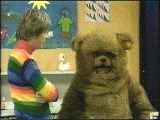 Much of the source material used by TV Offal comes from a little-known (outside of the TV industry) phenomenon known as ‘Christmas tapes’. These are unofficial compilations of programme and continuity-related material made by TV station staff in their spare time which often comprised of a collection of ‘outtakes’ (presenters fluffing their lines, etc.) compiled from such incidents recorded during the previous year but also may include clips specially recorded for the tape, originally intended for the staff’s own amusement only and not for transmission; the clip showing the Rainbow (kids’ TV show) team letting off steam with ‘the bad language’ being a prime example. The excerpt used in the pilot episode came from a Christmas 1978 tape produced by Thames Television staff.
Much of the source material used by TV Offal comes from a little-known (outside of the TV industry) phenomenon known as ‘Christmas tapes’. These are unofficial compilations of programme and continuity-related material made by TV station staff in their spare time which often comprised of a collection of ‘outtakes’ (presenters fluffing their lines, etc.) compiled from such incidents recorded during the previous year but also may include clips specially recorded for the tape, originally intended for the staff’s own amusement only and not for transmission; the clip showing the Rainbow (kids’ TV show) team letting off steam with ‘the bad language’ being a prime example. The excerpt used in the pilot episode came from a Christmas 1978 tape produced by Thames Television staff.
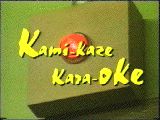 Every TV Offal featured one or two “Kamikaze Karaoke” sketches, whereby some of the most famous popular/classical music acts are seen performing, but their voices substituted with singing that is off-key/has different lyrics/etc., superimposed upon the same or similar musical backing. Guaranteed to bring the most egoistical superstar crashing down to earth, singers and acts which had been given the “This is what he sounds like to me” treatment included Pavarotti, Michael Jackson, Elvis Presley, Elton John, Bob Marley, Nigel Kennedy, Vanessa-Mae and that Manchester foursome Oasis.
Every TV Offal featured one or two “Kamikaze Karaoke” sketches, whereby some of the most famous popular/classical music acts are seen performing, but their voices substituted with singing that is off-key/has different lyrics/etc., superimposed upon the same or similar musical backing. Guaranteed to bring the most egoistical superstar crashing down to earth, singers and acts which had been given the “This is what he sounds like to me” treatment included Pavarotti, Michael Jackson, Elvis Presley, Elton John, Bob Marley, Nigel Kennedy, Vanessa-Mae and that Manchester foursome Oasis.
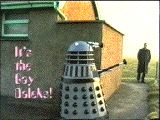 Probably the most controversial of TV Offal‘s regular features is the Gay Daleks: “They’re camp! They exterminate! Better watch your backs! It’s the Gay Daleks!” You either feel that the sketches are crude, tasteless and offensive, or they’re a splendid parody of both the Daleks and of gay cultural stereotypes; late night Channel 4 viewers (on the whole) would interpret them as the latter which is probably just as well given the content. Apparently they were popular with the gay community, though later attempts to produce a cartoon series based on the Gay Daleks did not materialise due to rights issues involving the Terry Nation estate.
Probably the most controversial of TV Offal‘s regular features is the Gay Daleks: “They’re camp! They exterminate! Better watch your backs! It’s the Gay Daleks!” You either feel that the sketches are crude, tasteless and offensive, or they’re a splendid parody of both the Daleks and of gay cultural stereotypes; late night Channel 4 viewers (on the whole) would interpret them as the latter which is probably just as well given the content. Apparently they were popular with the gay community, though later attempts to produce a cartoon series based on the Gay Daleks did not materialise due to rights issues involving the Terry Nation estate.
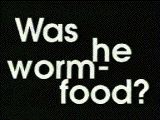 Another semi-regular feature that straddles the commercial break is “Assassination of the Week”. This sketch parodies the voyeurism that certain programmes seem to exhibit, namely, before the commercial break an assassination attempt is shown, and viewers are invited to guess “did they live or are they worm-food?”. After the break the rest of the film is shown and the answer is given, though there was a twist when the assassination of JFK was covered. Other politicians featured included Imelda Marcos, the woman which had a very large shoe collection.
Another semi-regular feature that straddles the commercial break is “Assassination of the Week”. This sketch parodies the voyeurism that certain programmes seem to exhibit, namely, before the commercial break an assassination attempt is shown, and viewers are invited to guess “did they live or are they worm-food?”. After the break the rest of the film is shown and the answer is given, though there was a twist when the assassination of JFK was covered. Other politicians featured included Imelda Marcos, the woman which had a very large shoe collection.
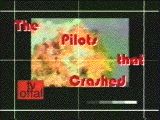 TV Offal often featured “The Pilots that Crashed”; one-off programmes that never got any further than the pilot episode or shows that had a very limited run. Perhaps controversially, the show featured “The Development of the Television Test Card” in show 2 which wasn’t a failed pilot programme; indeed it was a one-off show (made in 1985) aimed at a specialist audience as reference material therefore it was never intended to be commissioned as a broadcast series. But it featured one of Victor’s favourite subjects (as anyone seeing any earlier material of his would testify) so he couldn’t possibly ignore it!
TV Offal often featured “The Pilots that Crashed”; one-off programmes that never got any further than the pilot episode or shows that had a very limited run. Perhaps controversially, the show featured “The Development of the Television Test Card” in show 2 which wasn’t a failed pilot programme; indeed it was a one-off show (made in 1985) aimed at a specialist audience as reference material therefore it was never intended to be commissioned as a broadcast series. But it featured one of Victor’s favourite subjects (as anyone seeing any earlier material of his would testify) so he couldn’t possibly ignore it!
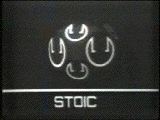 TV Offal regularly featured clips from the archives of student or hospital television stations, often featuring celebrities either before they became famous or making a guest appearence. Famous people featured included Michaela Strachan, Phillippa Forrester, and Christopher Biggins. The picture is taken from the ident used in 1969 of STOIC – Student Television of Imperial College (London).
TV Offal regularly featured clips from the archives of student or hospital television stations, often featuring celebrities either before they became famous or making a guest appearence. Famous people featured included Michaela Strachan, Phillippa Forrester, and Christopher Biggins. The picture is taken from the ident used in 1969 of STOIC – Student Television of Imperial College (London).
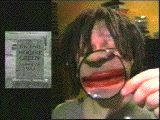 A TV Offal show wouldn’t be complete without one of Victor Lewis-Smith’s “specialities”, the wind-up phone call. He calls a famous person or organisation pretending to be someone else, with either hilarious or deeply embarrassing results. “Victims” included Carlton Television in the first show, the late Hughie Green and Mary Whitehouse. However the alleged ‘call’ to Mary Whitehouse landed Victor in a spot of bother, and it’s also interesting to note that phone calls of this nature are no longer permitted to be broadcast on UK television under Ofcom regulations.
A TV Offal show wouldn’t be complete without one of Victor Lewis-Smith’s “specialities”, the wind-up phone call. He calls a famous person or organisation pretending to be someone else, with either hilarious or deeply embarrassing results. “Victims” included Carlton Television in the first show, the late Hughie Green and Mary Whitehouse. However the alleged ‘call’ to Mary Whitehouse landed Victor in a spot of bother, and it’s also interesting to note that phone calls of this nature are no longer permitted to be broadcast on UK television under Ofcom regulations.
 The show is produced by Victor’s own production company, Associated-Rediffusion Television Ltd., which happens also to be the name of the ITV contractor that served London weekdays from 1955-1968. Victor bought the rights many years ago when it was simply ‘gathering dust’, and he even featured the voice of Redvers Kyle who was a regular continuity announcer for A-R in the 1950s (amongst others), in show 4. There will never be a commercial release (DVD/video download, etc.) of the TV Offal series because producer John Warburton found it difficult enough gaining copyright clearance for many of the clips used simply for television transmission.
The show is produced by Victor’s own production company, Associated-Rediffusion Television Ltd., which happens also to be the name of the ITV contractor that served London weekdays from 1955-1968. Victor bought the rights many years ago when it was simply ‘gathering dust’, and he even featured the voice of Redvers Kyle who was a regular continuity announcer for A-R in the 1950s (amongst others), in show 4. There will never be a commercial release (DVD/video download, etc.) of the TV Offal series because producer John Warburton found it difficult enough gaining copyright clearance for many of the clips used simply for television transmission.
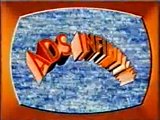 So, to paraphrase the “Assassination of the Week” feature, what happened next? The answer is the cleverly-titled Ads Infinitum – two series of ten-minute programmes shown on BBC2 (the first series in 1998), which (as the title suggests) are all about television or cinema adverts. And as for TV Offal itself, the only repeat showings were some compilation programmes (‘the best of’ or ‘the worst of’, depending on your point of view.) subsequently shown on Channel 4. These days Victor Lewis-Smith is occasionally still involved with television production and continues to be a newspaper TV critic and columnist for publications such as Private Eye; recent productions include Alchemists of Sound for BBC Four, You’re Fayed! for Channel 4 and a documentary The Undiscovered Peter Cook for BBC Four featuring some of the satirist’s personal diaries, letters, photographs and recordings.
So, to paraphrase the “Assassination of the Week” feature, what happened next? The answer is the cleverly-titled Ads Infinitum – two series of ten-minute programmes shown on BBC2 (the first series in 1998), which (as the title suggests) are all about television or cinema adverts. And as for TV Offal itself, the only repeat showings were some compilation programmes (‘the best of’ or ‘the worst of’, depending on your point of view.) subsequently shown on Channel 4. These days Victor Lewis-Smith is occasionally still involved with television production and continues to be a newspaper TV critic and columnist for publications such as Private Eye; recent productions include Alchemists of Sound for BBC Four, You’re Fayed! for Channel 4 and a documentary The Undiscovered Peter Cook for BBC Four featuring some of the satirist’s personal diaries, letters, photographs and recordings.
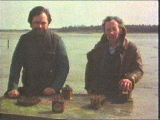 Ever wondered how everyday home appliances such as a fridge, fax machine, or central heating operated? Even if you hadn’t, The Secret Life of Machines series set out to explain simply and clearly how these (and more) items perform their functions. Presented by Tim Hunkin (right) and Rex Garrod, three series of programmes were produced for Channel 4 in 1988, 1991 and 1993 (the third series was entitled The Secret Life of the Office); all pictures shown here are taken from The Secret Life of the Television Set which was the last programme in the first series. Other programmes have since been produced that have names prefixed with “The Secret Life of…” (e.g. The Secret Life of the Zoo), but they are unrelated to The Secret Life of Machines/The Secret Life of the Office.
Ever wondered how everyday home appliances such as a fridge, fax machine, or central heating operated? Even if you hadn’t, The Secret Life of Machines series set out to explain simply and clearly how these (and more) items perform their functions. Presented by Tim Hunkin (right) and Rex Garrod, three series of programmes were produced for Channel 4 in 1988, 1991 and 1993 (the third series was entitled The Secret Life of the Office); all pictures shown here are taken from The Secret Life of the Television Set which was the last programme in the first series. Other programmes have since been produced that have names prefixed with “The Secret Life of…” (e.g. The Secret Life of the Zoo), but they are unrelated to The Secret Life of Machines/The Secret Life of the Office. A special feature is the use of (often humourous) cartoons that are used to illustrate ‘moments in history’ which are relevant to the appliance under discussion. This picture is taken from a cartoon used to show the moment when it was discovered that selenium can cause an electrical voltage to change dependent on the amount of light shining on it.
A special feature is the use of (often humourous) cartoons that are used to illustrate ‘moments in history’ which are relevant to the appliance under discussion. This picture is taken from a cartoon used to show the moment when it was discovered that selenium can cause an electrical voltage to change dependent on the amount of light shining on it. Tim Hunkin (the main presenter and architect of the series) may look exactly like the stereotypical image of “the professor”, but contrary to this he presents technology in a very straightforward and easy to understand manner and manages to do so in a way that can keep the interest of both novices and experts alike. His secret is possibly that if you’re not afraid of technology and you understand how an item works you can “deconstruct” an item into its various simpler components, and also avoiding unneccesary complexity when explaining how something operates.
Tim Hunkin (the main presenter and architect of the series) may look exactly like the stereotypical image of “the professor”, but contrary to this he presents technology in a very straightforward and easy to understand manner and manages to do so in a way that can keep the interest of both novices and experts alike. His secret is possibly that if you’re not afraid of technology and you understand how an item works you can “deconstruct” an item into its various simpler components, and also avoiding unneccesary complexity when explaining how something operates.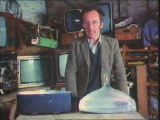 So how did Tim get into television? After gaining a Cambridge degree, he took on a series of bizarre commissions ranging from firework displays to mechanical sculptures. Back in 1972 he had drawn some cartoons for the Cambridge University newspaper Stop Press (the first one was about drawing cows!); this lead to a whole series of witty and factual cartoons for the Sunday Observer magazine colour supplement from 1973 to 1987 entitled “The Rudiments of Wisdom”, covering everything from acids to zoos (they were republished later in a book). Anticipating change at The Observer, Tim developed a proposal for a television series and his agent sent it to Channel 4. The rest, as they say, is history.
So how did Tim get into television? After gaining a Cambridge degree, he took on a series of bizarre commissions ranging from firework displays to mechanical sculptures. Back in 1972 he had drawn some cartoons for the Cambridge University newspaper Stop Press (the first one was about drawing cows!); this lead to a whole series of witty and factual cartoons for the Sunday Observer magazine colour supplement from 1973 to 1987 entitled “The Rudiments of Wisdom”, covering everything from acids to zoos (they were republished later in a book). Anticipating change at The Observer, Tim developed a proposal for a television series and his agent sent it to Channel 4. The rest, as they say, is history. Don’t try this at home kids! (Or for that matter, adults as well!) Who else would probably construct their own plasma lamp using the high voltage line output transformer from an old television set?
Don’t try this at home kids! (Or for that matter, adults as well!) Who else would probably construct their own plasma lamp using the high voltage line output transformer from an old television set?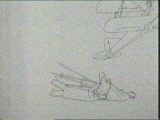 Humour can help make something more memorable, as many academic lecturers are sometimes keen to point out. A cartoon showing that the electronic-scanning Marconi-EMI system cameras (as opposed to the large fixed-position Baird mechanical scanning cameras) were much more versatile by showing someone using one to record a flying aircraft, and then showing the poor camerman being knocked over by the low-flying aircraft!
Humour can help make something more memorable, as many academic lecturers are sometimes keen to point out. A cartoon showing that the electronic-scanning Marconi-EMI system cameras (as opposed to the large fixed-position Baird mechanical scanning cameras) were much more versatile by showing someone using one to record a flying aircraft, and then showing the poor camerman being knocked over by the low-flying aircraft!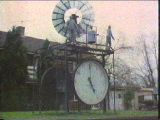 So what do Tim and Rex do when they’re not making television programmes? Well they make models and other mechanical devices for various organisations such as exhibitions and television programmes, and these were often featured to illustrate concepts throughout the series. This wind-powered mechanical clock was developed for the Liverpool Garden Festival some years ago.
So what do Tim and Rex do when they’re not making television programmes? Well they make models and other mechanical devices for various organisations such as exhibitions and television programmes, and these were often featured to illustrate concepts throughout the series. This wind-powered mechanical clock was developed for the Liverpool Garden Festival some years ago.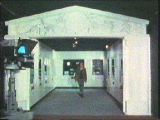 Tim Hunkin also designs and builds a lot of those ‘hands-on’ museum exhibits that interact in some way with the visitor; he designed this section for the National Museum of Photography, Film and Television in Bradford, Yorkshire. Amongst other commissions he has also developed for the Science Museum in London.
Tim Hunkin also designs and builds a lot of those ‘hands-on’ museum exhibits that interact in some way with the visitor; he designed this section for the National Museum of Photography, Film and Television in Bradford, Yorkshire. Amongst other commissions he has also developed for the Science Museum in London.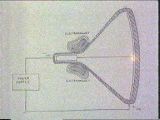 Here is an example of a display from the Bradford museum, showing how an electron beam generates a spot of light when it hits the phosphor-coated front surface of the cathode-ray tube.
Here is an example of a display from the Bradford museum, showing how an electron beam generates a spot of light when it hits the phosphor-coated front surface of the cathode-ray tube.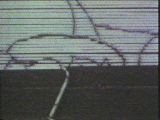 Tim and Rex are not afraid of using anything unusual to illustrate something that they are trying to explain – here they are using string with ink dots on it to illustrate how a television picture in constructed using scanning lines and dots of varying brightness.
Tim and Rex are not afraid of using anything unusual to illustrate something that they are trying to explain – here they are using string with ink dots on it to illustrate how a television picture in constructed using scanning lines and dots of varying brightness.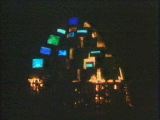 To conclude the first series they built an amazing funeral pyre consisting of old television sets which were faulty in some way but were not worth repairing. The stack of sets were all switched on when the flames were lit, and as the end credits rolled the TV screens flickered and died in turn as the flames rose higher and higher. However it has now been revealed that they wrongly thought the end credits would be less than a minute long therefore the fire was designed to burn quickly, meaning that they had to make the most out of using a relatively small quantity of film footage.
To conclude the first series they built an amazing funeral pyre consisting of old television sets which were faulty in some way but were not worth repairing. The stack of sets were all switched on when the flames were lit, and as the end credits rolled the TV screens flickered and died in turn as the flames rose higher and higher. However it has now been revealed that they wrongly thought the end credits would be less than a minute long therefore the fire was designed to burn quickly, meaning that they had to make the most out of using a relatively small quantity of film footage.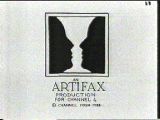 The programmes were mainly Tim Hunkin’s own work, though he had assistants to help him with various tasks such as production. Tim feels that although the shows were popular there was a danger that they were becoming “too formula-based”, so there are no further plans for any more “Secret Life” programmes – however in 1998 he planned to develop a TV series about photography which unfortunately didn’t materialise. Meanwhile he has numerous projects to keep him occupied; he gave a Science Museum talk entitled “Illegal Engineering” which was all about security and safe-cracking, and recent commissions include a Pirate Practice arcade machine installed at Southend Pier in 2012. He also has a “mad arcade of home-made machines & simulator rides” at Southwold Pier in Suffolk entitled “The Under The Pier Show” as well as machines at Novelty Automation based in London. Rex was last seen on the programme Robot Wars as part of a team which lost in a final.
The programmes were mainly Tim Hunkin’s own work, though he had assistants to help him with various tasks such as production. Tim feels that although the shows were popular there was a danger that they were becoming “too formula-based”, so there are no further plans for any more “Secret Life” programmes – however in 1998 he planned to develop a TV series about photography which unfortunately didn’t materialise. Meanwhile he has numerous projects to keep him occupied; he gave a Science Museum talk entitled “Illegal Engineering” which was all about security and safe-cracking, and recent commissions include a Pirate Practice arcade machine installed at Southend Pier in 2012. He also has a “mad arcade of home-made machines & simulator rides” at Southwold Pier in Suffolk entitled “The Under The Pier Show” as well as machines at Novelty Automation based in London. Rex was last seen on the programme Robot Wars as part of a team which lost in a final.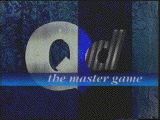 Over the years there have been many varieties of quiz show, from the intellectual (such as Call My Bluff) to the unashamedly populist Play Your Cards Right. QD: The Master Game was fundamentally similar to shows such as the mid-1980s TVS-produced Ultra Quiz, though it also had an affinity with the more intellectual shows. To briefly summarise – over five half-hour programmes (shown Monday to Friday on Channel 4 in 1991) an initially large number of contestants take part in a series of intellectual challenges; the number of contestants are reduced through elimination to a more manageable number for the final stages.
Over the years there have been many varieties of quiz show, from the intellectual (such as Call My Bluff) to the unashamedly populist Play Your Cards Right. QD: The Master Game was fundamentally similar to shows such as the mid-1980s TVS-produced Ultra Quiz, though it also had an affinity with the more intellectual shows. To briefly summarise – over five half-hour programmes (shown Monday to Friday on Channel 4 in 1991) an initially large number of contestants take part in a series of intellectual challenges; the number of contestants are reduced through elimination to a more manageable number for the final stages.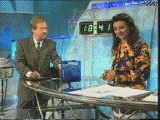 So what exactly did QD stand for, apart from yet another quiz game? An ongoing competition that took place during the five days when QD: The Master Game was shown was for viewers to guess what QD stood for, with the answer being revealed on Friday. To guess this one required knowledge of Latin and/or access to a Latin dictionary, since QD was an abbreviation for the Latin ‘quinque dies’ (or five days) – though if QD had reminded you of the famous abbreviation QED (quod erat demonstratum) you were probably half way there! This illustrates clearly that QD was not going to be just another ordinary quiz show.
So what exactly did QD stand for, apart from yet another quiz game? An ongoing competition that took place during the five days when QD: The Master Game was shown was for viewers to guess what QD stood for, with the answer being revealed on Friday. To guess this one required knowledge of Latin and/or access to a Latin dictionary, since QD was an abbreviation for the Latin ‘quinque dies’ (or five days) – though if QD had reminded you of the famous abbreviation QED (quod erat demonstratum) you were probably half way there! This illustrates clearly that QD was not going to be just another ordinary quiz show.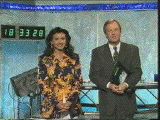 The presenters were the experienced Tim Brooke-Taylor (who was one of the Goodies – a popular BBC comedy show of the 1970s) and Lisa Aziz, who was the daughter of Khalid Aziz (he was a presenter who had worked for TVS, the ITV company who had also coincidentally produced Ultra Quiz). It seemed obvious that QD: The Master Game‘s format had been influenced by shows like The Krypton Factor along with the aforementioned Ultra Quiz.
The presenters were the experienced Tim Brooke-Taylor (who was one of the Goodies – a popular BBC comedy show of the 1970s) and Lisa Aziz, who was the daughter of Khalid Aziz (he was a presenter who had worked for TVS, the ITV company who had also coincidentally produced Ultra Quiz). It seemed obvious that QD: The Master Game‘s format had been influenced by shows like The Krypton Factor along with the aforementioned Ultra Quiz.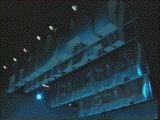 The studio set was fairly elaborate and must have cost quite a lot of time and money to construct (Noel Gay Productions must have been confident of QD being commissioned as a full series). This view of the studio gantry shows the large signs showing the days of the week: the appropriate one being lowered into view. The show also used video effects heavily, with captions spinning into view and an elaborate title sequence (which unfortunately we don’t have in its full form).
The studio set was fairly elaborate and must have cost quite a lot of time and money to construct (Noel Gay Productions must have been confident of QD being commissioned as a full series). This view of the studio gantry shows the large signs showing the days of the week: the appropriate one being lowered into view. The show also used video effects heavily, with captions spinning into view and an elaborate title sequence (which unfortunately we don’t have in its full form). By Friday (the show from which all of these pictures were taken) the number of contestants had been reduced to six, and all of them remained ‘in play’ in order to decide which person was to receive the £5000 prize.
By Friday (the show from which all of these pictures were taken) the number of contestants had been reduced to six, and all of them remained ‘in play’ in order to decide which person was to receive the £5000 prize.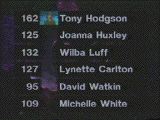 The person with the highest score at the start of Friday’s play (Tony Hodgson) was rarely troubled during the show and went on to win the final prize, though the prize for the contestant who was the most popular with the studio audience had to go to Wilba Luff, who was extrovert yet likeable (Wilba incidentally is a nickname for William). Simply mentioning his name provoked cheers and yelps from the audience; indeed the very concept of “getting to know the contestants” is very much a part of modern ‘reality’ TV formats and QD: The Master Game along with Ultra Quiz employed an “emotional journey” factor as part of their appeal years before programmes like Pop Idol were shown.
The person with the highest score at the start of Friday’s play (Tony Hodgson) was rarely troubled during the show and went on to win the final prize, though the prize for the contestant who was the most popular with the studio audience had to go to Wilba Luff, who was extrovert yet likeable (Wilba incidentally is a nickname for William). Simply mentioning his name provoked cheers and yelps from the audience; indeed the very concept of “getting to know the contestants” is very much a part of modern ‘reality’ TV formats and QD: The Master Game along with Ultra Quiz employed an “emotional journey” factor as part of their appeal years before programmes like Pop Idol were shown.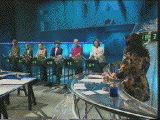 Fingers on buzzers! The challenges were a mixture of practical tests (see below) and general knowledge/memory tests; one which featured in Friday’s show was that the contestants had to try to memorise the contents of a book full of abbreviations – they were then tested on how much of the book they had actually remembered, though in this case some of the questions could be answered if you had good general knowledge skills. An example question: What does IMF stand for? (Answer: International Monetary Fund.)
Fingers on buzzers! The challenges were a mixture of practical tests (see below) and general knowledge/memory tests; one which featured in Friday’s show was that the contestants had to try to memorise the contents of a book full of abbreviations – they were then tested on how much of the book they had actually remembered, though in this case some of the questions could be answered if you had good general knowledge skills. An example question: What does IMF stand for? (Answer: International Monetary Fund.)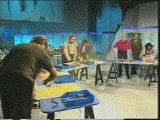 One of the ongoing challenges during the week was for the contestants to design a graphic logo which incorporated QD and the European flag symbol. No prizes for guessing who won this round…the others sadly didn’t stand much of a chance!
One of the ongoing challenges during the week was for the contestants to design a graphic logo which incorporated QD and the European flag symbol. No prizes for guessing who won this round…the others sadly didn’t stand much of a chance!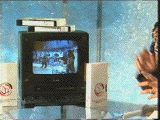 There must be at least six video copies of QD in existence, since the ‘losers’ (and I’m assuming Tony Hodgson as well) received a video cassette of the entire week’s programmes. The runners-up also each received this neat-looking 10″ television/video combination to play it on. Tony (to win the £5000) then had to answer 30 questions (based on all that he had done during the five days) in three minutes, which he did – but only just.
There must be at least six video copies of QD in existence, since the ‘losers’ (and I’m assuming Tony Hodgson as well) received a video cassette of the entire week’s programmes. The runners-up also each received this neat-looking 10″ television/video combination to play it on. Tony (to win the £5000) then had to answer 30 questions (based on all that he had done during the five days) in three minutes, which he did – but only just.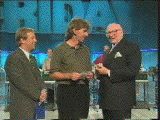 Tony Hodgson (centre) received his cheque for £5000 at the end – he was asked how he would spend the money. He replied that he would possibly buy a computer for educational purposes for his family (sensible chap that he is). We’ve worked out that at the time his options would have been either a 66 MHz 486 DX/2 PC or Apple Mac Quadra 900 4/160 (the latter leaving no change from £4095, and little change for extras such as a single-speed CD-ROM). Overall the general feeling was that both the contestants, the studio audience, and (hopefully) the viewers had enjoyed these five days in 1991.
Tony Hodgson (centre) received his cheque for £5000 at the end – he was asked how he would spend the money. He replied that he would possibly buy a computer for educational purposes for his family (sensible chap that he is). We’ve worked out that at the time his options would have been either a 66 MHz 486 DX/2 PC or Apple Mac Quadra 900 4/160 (the latter leaving no change from £4095, and little change for extras such as a single-speed CD-ROM). Overall the general feeling was that both the contestants, the studio audience, and (hopefully) the viewers had enjoyed these five days in 1991.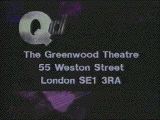 Despite the enthusiasm shown for the pilot, Channel 4 did not commission a full series; the official reason given (according to Tim Brooke-Taylor) was that it would have cost too much. Unofficially its demise may have been down to simply the fact that the relevant commissioning editor wasn’t too keen on the idea in the first place – it was Bill Cotton who came up with the idea, and his friend Michael Grade just happened to be head of Channel 4. QED. Tim also said that “I loved the scary week and cannot speak highly enough of the contestants and the production team. I also have a copy and am proud of the whole thing. But don’t ask me about commissioning editors.”
Despite the enthusiasm shown for the pilot, Channel 4 did not commission a full series; the official reason given (according to Tim Brooke-Taylor) was that it would have cost too much. Unofficially its demise may have been down to simply the fact that the relevant commissioning editor wasn’t too keen on the idea in the first place – it was Bill Cotton who came up with the idea, and his friend Michael Grade just happened to be head of Channel 4. QED. Tim also said that “I loved the scary week and cannot speak highly enough of the contestants and the production team. I also have a copy and am proud of the whole thing. But don’t ask me about commissioning editors.”
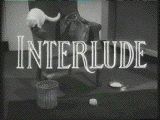 Programmes that featured flowers and plants were produced almost from day one; the very first week of programmes back in 1936 included one featuring prize chrysanthemums. Alexandra Palace (the BBC’s base from 1936 to 1960) has gardens which were an obvious choice to be used if the limited studio facilities were otherwise unavailable, though live outdoor programming was restricted sometimes by the unpredictable English weather.
Programmes that featured flowers and plants were produced almost from day one; the very first week of programmes back in 1936 included one featuring prize chrysanthemums. Alexandra Palace (the BBC’s base from 1936 to 1960) has gardens which were an obvious choice to be used if the limited studio facilities were otherwise unavailable, though live outdoor programming was restricted sometimes by the unpredictable English weather.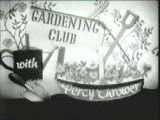 In 1956 the BBC started a monthly series that catered for real gardening enthusiasts, called Gardening Club. It was a big success, to such an extent that it established presenter Percy Thrower as a major celebrity (in a similar vein to Barry Bucknell, who was to be similiarly associated with do-it-yourself programmes).
In 1956 the BBC started a monthly series that catered for real gardening enthusiasts, called Gardening Club. It was a big success, to such an extent that it established presenter Percy Thrower as a major celebrity (in a similar vein to Barry Bucknell, who was to be similiarly associated with do-it-yourself programmes).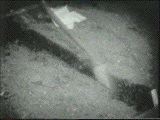 Outdoor television presents a whole set of challenges (rain, wind, etc.), but mishaps can still happen in the ‘controlled’ indoor studio environment. In order to effectively hear Percy Thrower’s voice, microphones were concealed in the soil (tiny radio microphones were yet to be developed), but once after he had finished putting plants into the soil, he started to water them, and since the concealed microphones were not waterproof…
Outdoor television presents a whole set of challenges (rain, wind, etc.), but mishaps can still happen in the ‘controlled’ indoor studio environment. In order to effectively hear Percy Thrower’s voice, microphones were concealed in the soil (tiny radio microphones were yet to be developed), but once after he had finished putting plants into the soil, he started to water them, and since the concealed microphones were not waterproof… In 1968 BBC2 were still experimenting with outdoor colour programming; the wide range of colours found in gardens were a natural choice for assessing colour accuracy. Six experimental gardening programmes were made using colour equipment; unfortunately all recordings of these have been lost.
In 1968 BBC2 were still experimenting with outdoor colour programming; the wide range of colours found in gardens were a natural choice for assessing colour accuracy. Six experimental gardening programmes were made using colour equipment; unfortunately all recordings of these have been lost.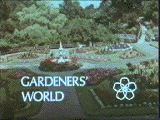 BBC2 (and colour television) was the natural home for gardening programmes, so Gardeners’ World started on Friday 5 January 1968 as a series to fulfill the demand for such programming. The main presenter was (again) Percy Thrower, though this time there were various co-presenters such as Arthur Billett, Kenneth Burras, Alice Coats and Geoffrey Smith. Gardeners’ World – with or without the apostrophe – has continued to the present day, albeit with an occasionally-changing roster of presenters.
BBC2 (and colour television) was the natural home for gardening programmes, so Gardeners’ World started on Friday 5 January 1968 as a series to fulfill the demand for such programming. The main presenter was (again) Percy Thrower, though this time there were various co-presenters such as Arthur Billett, Kenneth Burras, Alice Coats and Geoffrey Smith. Gardeners’ World – with or without the apostrophe – has continued to the present day, albeit with an occasionally-changing roster of presenters.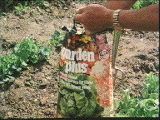 All was running smoothly until 1976, when Percy Thrower did (in many people’s eyes) the unthinkable and appeared in a TV commercial for Garden Plus fertiliser. His name was already associated with gardening products, but this commercial meant that it was possible for viewers to watch ITV and see him actively endorsing a product, then switch over to BBC2 and see him again in the garden. The result could have confused some people, as well as going against the principles of non-commercial television, so the BBC did what they thought was necessary by sacking him.
All was running smoothly until 1976, when Percy Thrower did (in many people’s eyes) the unthinkable and appeared in a TV commercial for Garden Plus fertiliser. His name was already associated with gardening products, but this commercial meant that it was possible for viewers to watch ITV and see him actively endorsing a product, then switch over to BBC2 and see him again in the garden. The result could have confused some people, as well as going against the principles of non-commercial television, so the BBC did what they thought was necessary by sacking him.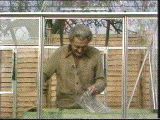 Life must go on (after all there’s the grass to be cut…), so Percy Thrower was replaced by Peter Seabrook, who didn’t exactly look like a typical gardener (quote: “He looked more like an accountant”), though the co-presenters such as Arthur Billit, Geoffrey Smith and Clay Jones (pictured) remained the same, helping to smooth the transition. Replacing Percy Thrower was always going to be difficult, but the loyalty of the viewers and the quality of the current and later presenters kept the show going. After all, the show was all about gardening and not personalities.
Life must go on (after all there’s the grass to be cut…), so Percy Thrower was replaced by Peter Seabrook, who didn’t exactly look like a typical gardener (quote: “He looked more like an accountant”), though the co-presenters such as Arthur Billit, Geoffrey Smith and Clay Jones (pictured) remained the same, helping to smooth the transition. Replacing Percy Thrower was always going to be difficult, but the loyalty of the viewers and the quality of the current and later presenters kept the show going. After all, the show was all about gardening and not personalities.
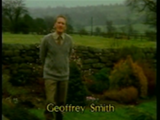
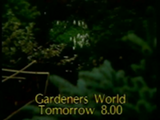 Geoffrey Smith featured in this promotion for a new series of Gardeners World (sometimes spelt without an apostrophe, as is the case here) in 1981, talking about tomato plants and how they are flowering earlier in the South of England compared to elsewhere in the UK.
Geoffrey Smith featured in this promotion for a new series of Gardeners World (sometimes spelt without an apostrophe, as is the case here) in 1981, talking about tomato plants and how they are flowering earlier in the South of England compared to elsewhere in the UK.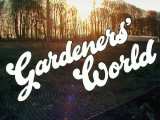 This is what the Gardeners’ World titles looked like in 1982 – at this point the theme music was still the same as it was in the 1970s – with the typeface employed bearing a resemblance to that used by a certain brand of flower seed.
This is what the Gardeners’ World titles looked like in 1982 – at this point the theme music was still the same as it was in the 1970s – with the typeface employed bearing a resemblance to that used by a certain brand of flower seed.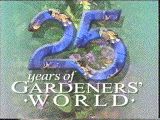 Garden technology may evolve with the introduction of more advanced pesticides, plant varieties and garden machinery, but Gardeners’ World still carried on regardless, celebrating its 25th anniversary in 1994. The show had been contracted out to independent producers in 1993 and some had complained about the changes, but the show must go on (as they say). In recent years the gardens featured have been in a wider range of locations due to smaller and lighter video equipment becoming available.
Garden technology may evolve with the introduction of more advanced pesticides, plant varieties and garden machinery, but Gardeners’ World still carried on regardless, celebrating its 25th anniversary in 1994. The show had been contracted out to independent producers in 1993 and some had complained about the changes, but the show must go on (as they say). In recent years the gardens featured have been in a wider range of locations due to smaller and lighter video equipment becoming available.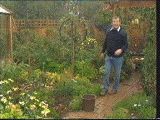 One of the best-loved presenters of Gardeners’ World was Geoff Hamilton (1990-1996), who tragically died from a heart attack shortly before the series Geoff Hamilton’s Paradise Gardens was completed (his brother helped to complete the final episode). His garden (known as Barnsdale) was an inspiration to tired gardeners everywhere; infact there had been two ‘Barnsdales’ (the first one had become too small); the larger final one actually comprising of no less than thirty separate smaller gardens.
One of the best-loved presenters of Gardeners’ World was Geoff Hamilton (1990-1996), who tragically died from a heart attack shortly before the series Geoff Hamilton’s Paradise Gardens was completed (his brother helped to complete the final episode). His garden (known as Barnsdale) was an inspiration to tired gardeners everywhere; infact there had been two ‘Barnsdales’ (the first one had become too small); the larger final one actually comprising of no less than thirty separate smaller gardens. As well as being a well-loved presenter, Geoff Hamilton made one very significant contribution to the world of agriculture (not just gardening), notably the promotion of organic methods of pest control and the elimination of chemicals from the food chain at a time when such methods had fallen out of favour (and organic food was virtually unobtainable). Also he wasn’t afraid to show viewers the results of such organic experiments even if they had failed, since the point of the exercise was to learn from these mistakes, and crucially these organic methods were presented as an alternative to the use of conventional pesticides (which were also used as a comparison) as opposed to only being told one way of doing things.
As well as being a well-loved presenter, Geoff Hamilton made one very significant contribution to the world of agriculture (not just gardening), notably the promotion of organic methods of pest control and the elimination of chemicals from the food chain at a time when such methods had fallen out of favour (and organic food was virtually unobtainable). Also he wasn’t afraid to show viewers the results of such organic experiments even if they had failed, since the point of the exercise was to learn from these mistakes, and crucially these organic methods were presented as an alternative to the use of conventional pesticides (which were also used as a comparison) as opposed to only being told one way of doing things. From 1996, Gardeners’ World continued with Alan Titchmarsh becoming the main presenter along with Pippa Greenwood and Gay Search being regular presenters in 1998 as the show reached its 30th year. Alan Titchmarsh subsequently moved on in 2002 to other areas such as replacing Sheridan Morley as the presenter of the Radio 2 Arts Programme, and Monty Don took over as the main presenter.
From 1996, Gardeners’ World continued with Alan Titchmarsh becoming the main presenter along with Pippa Greenwood and Gay Search being regular presenters in 1998 as the show reached its 30th year. Alan Titchmarsh subsequently moved on in 2002 to other areas such as replacing Sheridan Morley as the presenter of the Radio 2 Arts Programme, and Monty Don took over as the main presenter. Gardeners’ World celebrated its 40th year in 2008 and still survives to this day despite competing series such as Ground Force vying for attention. Monty Don had to take a break in 2009 due to health concerns despite his popularity. He was replaced by co-presenter Toby Buckland in 2009, and after a short-lived revamp of the show that used 60 minute-long episodes with added features which had been likened (amongst other things) to elements of programmes such as popular motoring show Top Gear (by featuring a ‘cool wall’) and CBeebies by virtue of featuring young children, Gardeners’ World essentially returned to its roots in 2010 with a reversion to a 30-minute format, with Monty Don returning to the show soon afterwards.
Gardeners’ World celebrated its 40th year in 2008 and still survives to this day despite competing series such as Ground Force vying for attention. Monty Don had to take a break in 2009 due to health concerns despite his popularity. He was replaced by co-presenter Toby Buckland in 2009, and after a short-lived revamp of the show that used 60 minute-long episodes with added features which had been likened (amongst other things) to elements of programmes such as popular motoring show Top Gear (by featuring a ‘cool wall’) and CBeebies by virtue of featuring young children, Gardeners’ World essentially returned to its roots in 2010 with a reversion to a 30-minute format, with Monty Don returning to the show soon afterwards.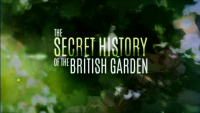 As well as Gardeners’ World there have been other gardening-related programmes including The Secret History of the British Garden, also presented by Monty Don. This four-part series covering the 17th, 18th, 19th and 20th centuries was originally broadcast in December 2017 and charted the progress of gardening from when it was a preserve of wealthy land owners and royalty right up to the present day as a mass market hobby. January 2018 is the 50th anniversary of Gardeners’ World and the UK’s love affair with horticulture shows no signs of going away.
As well as Gardeners’ World there have been other gardening-related programmes including The Secret History of the British Garden, also presented by Monty Don. This four-part series covering the 17th, 18th, 19th and 20th centuries was originally broadcast in December 2017 and charted the progress of gardening from when it was a preserve of wealthy land owners and royalty right up to the present day as a mass market hobby. January 2018 is the 50th anniversary of Gardeners’ World and the UK’s love affair with horticulture shows no signs of going away. The 1970s was a period of great change for television in general – at the start of the decade colour had only been available on BBC1 and ITV for a few months (and only from key main transmitters), and over half of programmes were still in black and white. The decade that brought bread shortages, power cuts, disco dancing, decimalisation, ABBA, and the Queen’s Silver Jubilee was also responsible for the following BBC children’s television programmes; just a small number of which are illustrated below for your enjoyment. (Just incase you were wondering about The White Seal, it was a cartoon based on a Rudyard Kipling story.)
The 1970s was a period of great change for television in general – at the start of the decade colour had only been available on BBC1 and ITV for a few months (and only from key main transmitters), and over half of programmes were still in black and white. The decade that brought bread shortages, power cuts, disco dancing, decimalisation, ABBA, and the Queen’s Silver Jubilee was also responsible for the following BBC children’s television programmes; just a small number of which are illustrated below for your enjoyment. (Just incase you were wondering about The White Seal, it was a cartoon based on a Rudyard Kipling story.)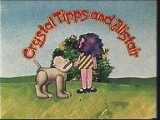

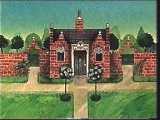
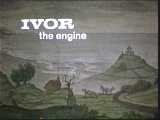
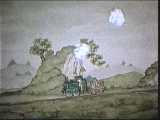
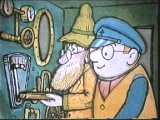
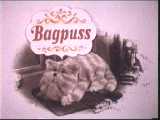
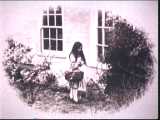
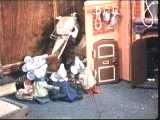
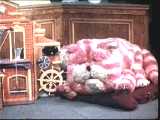 Bagpuss (1974) was a cleverly-conceived animation based around a saggy old cloth cat in a junk shop, which magically came to life together with the shop’s numerous other inhabitants such as Professor Yaffel the wooden woodpecker which normally served as a bookend. The girl Emily (second picture above) who owned Bagpuss was infact Peter Firmin’s youngest daughter. Many regard Bagpuss as the greatest childrens’ television programme of all time, though some may prefer the all-time classic Pogles Wood or The Clangers from the same Smallfilms stable.
Bagpuss (1974) was a cleverly-conceived animation based around a saggy old cloth cat in a junk shop, which magically came to life together with the shop’s numerous other inhabitants such as Professor Yaffel the wooden woodpecker which normally served as a bookend. The girl Emily (second picture above) who owned Bagpuss was infact Peter Firmin’s youngest daughter. Many regard Bagpuss as the greatest childrens’ television programme of all time, though some may prefer the all-time classic Pogles Wood or The Clangers from the same Smallfilms stable. Play School started life as the first proper programme to be transmitted on BBC2’s first day in 1964, after a power cut had wiped out what was to have been the official opening ceremony the night before. Play School soon went on to be a favourite with pre-school children to such an extent that a spinoff series Play Away was created for older children, and Play School itself continued throughout the 1970s right up to its eventual demise in 1988. Each edition was usually first shown on BBC2 in a mid-morning slot followed by a repeat showing on BBC1 for those viewers who couldn’t yet receive BBC2.
Play School started life as the first proper programme to be transmitted on BBC2’s first day in 1964, after a power cut had wiped out what was to have been the official opening ceremony the night before. Play School soon went on to be a favourite with pre-school children to such an extent that a spinoff series Play Away was created for older children, and Play School itself continued throughout the 1970s right up to its eventual demise in 1988. Each edition was usually first shown on BBC2 in a mid-morning slot followed by a repeat showing on BBC1 for those viewers who couldn’t yet receive BBC2.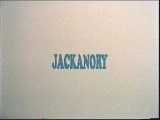


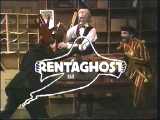
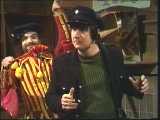
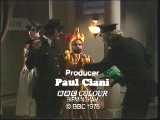

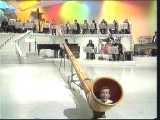
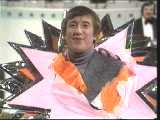


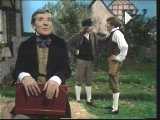
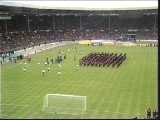 This feature is not about football or soccer itself (there are lots of other sites catering for football fans), but these pictures of the match between England and Scotland that took place at Wembley Stadium on 26 May 1979 help illustrate the BBC’s style of television presentation of football matches during the late 1970s/early 1980s, including the various on-screen captions that were used.
This feature is not about football or soccer itself (there are lots of other sites catering for football fans), but these pictures of the match between England and Scotland that took place at Wembley Stadium on 26 May 1979 help illustrate the BBC’s style of television presentation of football matches during the late 1970s/early 1980s, including the various on-screen captions that were used. This comprehensive graphic display was used for team details at the start of the match together with the team’s crest. The England team of this era featured famous players such as Kevin Keegan, Steve Coppell and Trevor Brooking who was later to become a familiar face on BBC1 as a football pundit.
This comprehensive graphic display was used for team details at the start of the match together with the team’s crest. The England team of this era featured famous players such as Kevin Keegan, Steve Coppell and Trevor Brooking who was later to become a familiar face on BBC1 as a football pundit.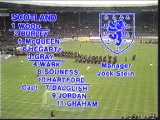 And ditto for the opposing team – in this case Scotland.
And ditto for the opposing team – in this case Scotland.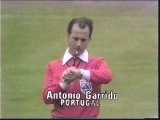 The referee (Antonio Garrido, from Portugal) was deemed important enough to have an on-screen caption all of his own. He checks his watch, waiting for play to begin.
The referee (Antonio Garrido, from Portugal) was deemed important enough to have an on-screen caption all of his own. He checks his watch, waiting for play to begin.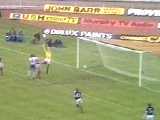 This (enlarged) view of the goal mouth shows some of the advertisement hoardings used at the time. Note the advertisements for Bush and Murphy – two electrical brand names that were prominent in the 1970s – the Bush brand is now owned by Sainsbury’s who own the chain of Argos catalogue shops in the UK and Ireland, amongst other concerns.
This (enlarged) view of the goal mouth shows some of the advertisement hoardings used at the time. Note the advertisements for Bush and Murphy – two electrical brand names that were prominent in the 1970s – the Bush brand is now owned by Sainsbury’s who own the chain of Argos catalogue shops in the UK and Ireland, amongst other concerns.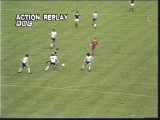 The advent of video disc recording in 1968 meant that action replays (including slow motion and still frames without any interference) were possible without any delay involved in rewinding a videotape, though this was confined only to the last 33 seconds of play which was being recorded in a continuous loop. The BBC showed briefly an onscreen caption (which included the BBC logo) at the beginning of the replay to let viewers know what they were watching; not long afterwards – well at least by January 1980 – this reminder was used far less often presumably because viewers had been long accustomed to this sort of thing.
The advent of video disc recording in 1968 meant that action replays (including slow motion and still frames without any interference) were possible without any delay involved in rewinding a videotape, though this was confined only to the last 33 seconds of play which was being recorded in a continuous loop. The BBC showed briefly an onscreen caption (which included the BBC logo) at the beginning of the replay to let viewers know what they were watching; not long afterwards – well at least by January 1980 – this reminder was used far less often presumably because viewers had been long accustomed to this sort of thing.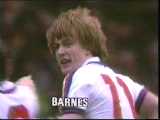 When something of note happened during the game (such as a goal being scored) a caption would often briefly appear identifying the person involved – in this case Peter Barnes who scored the equalising goal for England shortly before the half-time whistle.
When something of note happened during the game (such as a goal being scored) a caption would often briefly appear identifying the person involved – in this case Peter Barnes who scored the equalising goal for England shortly before the half-time whistle.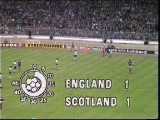 These were the days before the occasional use of a permanent on-screen display of the current score – viewers had to keep track of the game themselves for much of the time, in which case you had to be watching from the start or have a friend tell you the score. Hence this graphic was very important when it appeared – it also incorporated a football-shaped clock with a white band indicating elapsed time since the start of play.
These were the days before the occasional use of a permanent on-screen display of the current score – viewers had to keep track of the game themselves for much of the time, in which case you had to be watching from the start or have a friend tell you the score. Hence this graphic was very important when it appeared – it also incorporated a football-shaped clock with a white band indicating elapsed time since the start of play.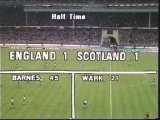 At the end of half (or full) time this noticeboard-style caption was used which helpfully gave details of who scored what goals and when. Also note the absence of any form of electronic scoreboard or large screen display(s) in the stadium which are so common today.
At the end of half (or full) time this noticeboard-style caption was used which helpfully gave details of who scored what goals and when. Also note the absence of any form of electronic scoreboard or large screen display(s) in the stadium which are so common today.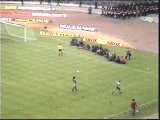 The marching band (a regular fixture during the interval to ‘entertain’ the crowd during and before this period) barely had the chance to leave the pitch when play started again!
The marching band (a regular fixture during the interval to ‘entertain’ the crowd during and before this period) barely had the chance to leave the pitch when play started again!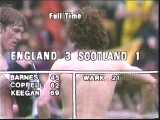 Match over – Ron Greenwood’s England team had beaten Jock Stein’s Scotland (something that wasn’t entirely expected) and the team captains (Dalglish and Keegan) swapped shirts.
Match over – Ron Greenwood’s England team had beaten Jock Stein’s Scotland (something that wasn’t entirely expected) and the team captains (Dalglish and Keegan) swapped shirts.